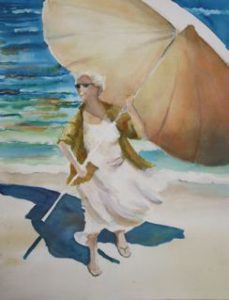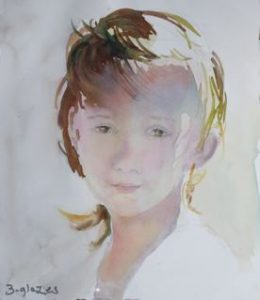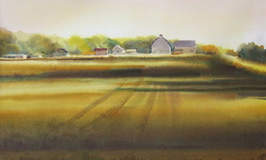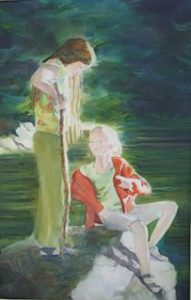
Queen of Crescent Beach I started and stayed with the dye pigments — glazing in the umbrella but no darker than mid-value. The dark shadow was painted with dye pigments once-wet blending the shape. Water was first wet-wet then dried. Negative painting back from the umbrella.
I find the more students study with different instructors, read a variety of books, watch U Tube videos, etc, the more confused they become about which paints are really necessary to own to paint the way they wish.
And they do exactly what the paint manufacturers want: They buy more tubes of paint than they can possibly use.
Theoretically you can make all of your colors out of RED, YELLOW and BLUE. But you may find that you can’t always mix the pure ORANGE, GREEN or VIOLET you want, so you buy three more.
For about three years (late ’70’s, early 80’s) I painted with only Alizeran Crimson, Cadmium Yellow Light, and Thalo blue. Well, 4. Early on I added Thalo green.

Star Gazer
The skin-tones were achieved with three separate glazes, drying between. First aurolean yellow. Next quinacridone rose. Finally cobalt blue. There are pinks, apricot, lavender all made of overlapping primaries.
We were doing a lot of glazing, strongly influenced by Richard Nelson of Hawaii. I found I could get beautiful colors as long as I stayed fairly high-key or light. I could glaze some combinaion of red, yellow and blue to get neutrals and could make every hue in between.
But I couldn’t get color-filled darks. Mud. Or just ugly. The answer? It took me a long time to work it out. See the article at the end of ABOUT in this website– Inksmith, Daniel Smith, Making Sense of Pigments. Also see the June, 2017 posting for a list of the 20 pigments I use.

Pioneer Highway The are three glazes similar to Star Gazer. The field was cad. yellow first. Next quin. gold in places. Shadows with thalo green. Final glaze of ultramarine blue in the middle distance, Indian Red in the foreground.
Summary:
- painting the same scene all in staining pigments, demonstrating their strengths and weaknesses
- painting it again in sedimentary pigments, again showing strengths and weaknesses
- next in the combination of cobalt blue, rose madder genuine, aurolean yellow, and viridian
- finally: Intelligent Choices with
- Stains (dyes) for the first wash colors,
- they flow easily with the water – you can create direction with gesture
- they intermingle with other hues creating fascinating blends
- they bond with the paper as they dry so they do NOT wash up in later glazes
- Use the dye colors for easy mixing when you do wet blending (small wet areas)
- Use the dye pigments when you overglaze if it is a light to middle vlaue area
- Use them for strong undercolor (often of a warmer or different hue) where you plan to go dark
- Sedimentary pigments for over-glazing for texture,

“How Deep” was giving me trouble. The viewer wasn’t drawn to the sunlight on the girls. I had too much middle value in the sunlight on the firs in the background. In explaining the problem to another artist, I realized what I had to do. I wet the whole sheet again(in a tub of water), let it drip until the drips stopped and then floated in great amounts of Ultramarine blue. Still not right. Now it was too blue-green. I blended quinacridone violet into the wet Ultramarine. I would have had MUD if I had tried to add the violet after the Ultramarine had dried. The gold/green trees did not wash up into the Ultramarine/violet glaze because they had bonded with the paper.
resonance and getting strong darks that are still color filled (see earlier technique corners for more on this)
- The “transparent” or luminous pigment group for subtle adjustments or for very delicate subjects
- Stains (dyes) for the first wash colors,
Hands on? Come to Orcas August 7 & 8.
Happy painting!
Caroline
© Caroline Buchanan, 2017
In Callie Running on the lead page, we have strong cadmium yellow and quinacridone gold in the first wet-on-wet. Second wet-on-wet of thalo green, mixed with ultramarine blue at the top and quin. gold at the bottom. Negative painting using those pigments.
